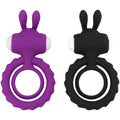Kinbaku and Shibari: The Art of Japanese Rope Bondage
Posted by MARIA LOCKE

The Aesthetic Beauty of Shibari
Shibari is often celebrated as a form of living body art. Rope patterns flow across the skin, accentuating natural curves and posture in a way that is both visual and intimate. Each tie becomes an expression of connection between the rigger and the person being tied. The beauty lies not only in the final form but also in the mindful, intentional process of tying. Wrapping, knotting, and adjusting each strand of rope creates a rhythm that deepens intimacy and builds trust through presence and shared awareness.
The Erotic and Emotional Elements of Kinbaku
Kinbaku explores the emotional and erotic depth of rope bondage. Here, the rope serves as more than just a physical restraint, it becomes a channel for intention, care, dominance, and surrender. For the person tying, it offers a way to express control and desire. For the one being tied, it can invite sensations of vulnerability, pleasure, catharsis, or release. The pressure, stillness, and deliberate restraint create a powerful dynamic of trust and connection. This emotional intensity is what makes Kinbaku a deeply transformative and intimate practice for many.
Common Rope Materials and Their Significance
The rope you choose can significantly affect the experience. Traditional materials like jute and hemp are popular for their natural texture and grip, providing sensory feedback that enhances each tie. These ropes are often conditioned to strike the right balance between softness and bite. Cotton ropes are smoother and gentler on the skin, making them a great choice for beginners. Synthetic options like nylon or polyester offer durability and vibrant colors, though they feel slicker and may lack the tactile nuance of natural fibers. If you're just getting started, try the Trio Hide Deluxe Cowhide Bondage Play Set, a beginner-friendly kit that includes multiple accessories to help you explore with comfort and style.
Essential Safety Considerations
Safety should always come first in Kinbaku and Shibari play. Before tying begins, partners must communicate openly about boundaries, limits, and intentions. Agree on a safe word or non-verbal signal that either person can use to pause or stop at any moment. During play, regularly check for numbness, tingling, or changes in skin color that may indicate restricted circulation. Avoid tying over sensitive joints or major nerve areas like the wrists, neck, and inner thighs. Always have safety shears or a rope cutter nearby for quick release. Taking these precautions ensures that every session remains grounded in mutual care and safety.

Getting Started with Shibari and Kinbaku
For beginners, starting with the basics builds confidence and creates a strong foundation for exploration. Seek out online tutorials, books by reputable educators, or hands-on workshops. Easy beginner ties include the single-column and double-column ties or a basic chest harness. These are safe, versatile, and open up a world of possibilities. A great entry point is the ROOMFUN Premium Bondage Set, which includes a variety of ropes and accessories designed to help you discover and develop your style in a safe and accessible way.
Tools and Accessories Beyond Rope
While rope is at the heart of Kinbaku and Shibari, many practitioners incorporate other tools to enhance both safety and creativity. Suspension rings, carabiners, and overhead anchor points are essential for more advanced work and should always be used with care and proper training. Soft padding or mats provide protection during floor or suspension play. Essentials like safety shears should always be within reach. For added flair, accessories can elevate the aesthetic of your session. The Elegant Rhinestone Embellished Lingerie Set is perfect for layering under rope, and the PU Leather Bondage Kit adds both structure and seductive visual appeal.
The Role of Ritual and Mindfulness
Kinbaku and Shibari are more than just techniques, they are often experienced as intentional rituals. From selecting your rope to setting the mood, each step can become part of a mindful practice. Creating a calm, focused environment encourages presence and emotional connection between partners. The slow, deliberate act of tying builds trust and heightens awareness of each other’s cues. To enhance the sensory and visual experience, consider wearing something striking like the Your Highness Sexy Leg Harness. It adds a bold, elegant touch that complements the flow of rope across the body.
Kinbaku and Shibari in Modern Media
Rope bondage has gained traction in art, performance, and fashion. Shibari has been featured in gallery exhibitions, live shows, and editorial shoots, where the intricate ties reflect themes of vulnerability, strength, and erotic tension. However, as the practice becomes more visible, it’s important to maintain respect for its cultural roots. Whether you're tying for visual impact or personal exploration, tools like the ROOMFUN Premium Nylon Shibari Bondage Rope offer a clean, sleek aesthetic with excellent durability, ideal for creating visually stunning ties that photograph beautifully.
Common Misconceptions
There are many misconceptions surrounding rope bondage. One is that it's only for sexual gratification. While it can absolutely be erotic, many people explore rope for its meditative qualities, emotional depth, or artistic expression. Another common myth is that bondage is inherently dangerous. In truth, when practiced with communication, consent, and basic safety knowledge, it can be incredibly safe and empowering. Tools like the Fetish Fantasy Wraparound Mattress Restraints can offer a secure yet beginner-friendly way to explore restraint without complicated knots or suspension setups, making the experience approachable and fun.
Respecting the Cultural Roots
As Kinbaku and Shibari continue to grow in global popularity, it's important to honor their cultural origins. These practices are deeply rooted in Japanese history and aesthetics, and carry meanings beyond the physical ties. Practitioners are encouraged to engage with the tradition respectfully, learning from experienced teachers, acknowledging Japanese influence, and avoiding cultural appropriation. By approaching rope bondage with intention and understanding, we preserve its integrity and pay tribute to the generations of artistry that shaped it.
Kinbaku and Shibari for Couples
Rope bondage can be a deeply bonding activity for couples, offering a unique way to explore trust, communication, and sensuality. Tying and being tied together can create moments of vulnerability, care, and discovery. It’s an invitation to slow down and engage in something creative and intimate. For couples looking to expand their play, the TOUGHAGE Passion Series Restraint Kit offers a versatile mix of gear to try new positions and scenarios, while still keeping things safe and playful.
Final Thoughts
Kinbaku and Shibari offer more than visual appeal or physical restraint, they invite us into a world of trust, mindfulness, and artistic connection. Whether you're drawn to the aesthetic flow of Shibari, the emotional power of Kinbaku, or simply curious about rope play, there is room for everyone to explore at their own pace. Start with simple techniques, prioritize safety, and enjoy the journey. If you're ready to try something more structured or hands-free, explore options like the TOUGHAGE Vibrator Fixing Kit, designed for playful experimentation and added pleasure during bondage sessions.
Frequently Asked Questions (FAQs)
Is Shibari suitable for beginners?
Yes. Shibari can be practiced at a beginner level with simple ties that are both safe and beautiful. Many people start with basic single-column or double-column ties and progress as they gain skill and confidence. Taking a class or following guidance from reputable sources is recommended for beginners.
Can I practice Kinbaku on my own?
Some elements of Kinbaku, such as self-tying or practicing knots, can be done solo. However, the emotional and connection aspects of Kinbaku typically involve a partner. Those interested in self-bondage should take extra safety precautions and plan for emergency release options.
What type of rope is best for starting?
Many beginners choose soft cotton rope because it is gentle on the skin and easy to handle. As you become more experienced, you may wish to try jute or hemp, which offer more texture and hold. The best rope for starting is one that feels comfortable and safe for your intended use.
How can I find reputable learning resources?
Look for workshops taught by experienced instructors, trusted online tutorials, or books authored by respected practitioners. Community groups, rope studios, and kink-friendly events can also be good places to learn in a supportive environment.
Is suspension safe for beginners?
Suspension is an advanced practice that requires solid knowledge of rope technique, anatomy, and safety measures. Beginners are encouraged to focus on floor-based ties first. If you wish to learn suspension, seek hands-on instruction from experienced teachers to ensure safe and responsible practice.



















